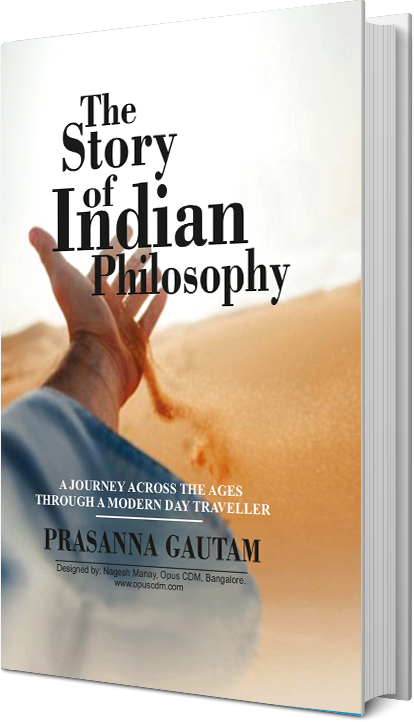The Story of Indian Philosophy
The working title for this book at first was “Indian Philosophy, which I always wanted to know but had no time to do so.”
Indian philosophy appears at first to be a bewildering plethora of concepts, and this curious potpourri of faith and logic has made Indian Philosophy an enigma. This short work has squeezed a period of several millennia and prevented the evolution of concepts in a quasi-historical manner to demonstrate the dynamic nature of Indian philosophy. I hope this makes it different and more comprehensive than the hitherto published scholarly books on the subject.
Despite the brevity of the presentation, the contents of this book are sufficiently informative to satisfy those who wish to know about it but are hard-pressed for time. The first few paragraphs give the essence of the full text in the chapter, and a general reader needs not to go through the white text. The detailed text is for the students, researchers, and teachers. Footnotes, references, and a bibliography aid any serious study.
Buy at amazon Buy at Buy Books India

About the Author
Dr Prasanna Chandra Gautam - MBBS, MRCP (UK), FRCP Edin., FRCPS, Glasgow, FRSPH (UK). He has been studying ancient Sanskrit literature since 2005. Formerly, he was a Consultant Physician and a Senior Lecturer in Medicine at Aberdeen University. Scotland and an Honorary Professor of Gerontology at Manmohan Memorial Institute of Health Sciences in Kathmandu. He was educated in Kathmandu, Varanasi, Bangalore, and the UK. He was born into an orthodox Brahmin family in Nepal, where he grew up being familiar with the traditional customs and rituals. Being an experienced science researcher and teacher, he is well placed to interpret ancient Sanskrit texts and present them coherently and systematically. He has translated the Rig Veda word for word from Sanskrit into English, Nepali, and Hindi. He lives with his wife Leela in Aberdeen, Scotland.
Besides many technical papers on medicine, his other publications include:
Explore the Book
Discussion on two favourite chapters
Chapter 1: Introduction
This introduces most of the issues comprehensively from the background of existing literature. This also highlights continuity in misinformation and conjectures presented by the scholars. Finally, the text suggests a scientific and objective way of looking at the existing literature, which is logical and comprehensible. These concepts are the main quest for peace, bliss, and equanimity, which are essential to modern times, too.
Chapter 23: Conclusion
The author suggests a few inferences based on this vast literature.
- i) The Vedic Concept of social structure could be adapted to suit modern times.
- ii) Each person should design and follow their religion which should have no intermediary between him and his faith. They should worship in private and have no commonplace preaching or worshipping. This is to avoid herding mankind into adversarial religious camps, and this will prevent conflicts, wars, deaths, and destruction.
- iii) Let society determine an upper limit too for accumulating personal wealth. It will be in the interest of the whole society to narrow the widening divide between the rich and poor.
About the Book
This book is a distillate of the vast Indian literature on Indian philosophy, culture, and religions. This spans several millennia and has been presented briefly, objectively, and with authority, demonstrating Professor Gautam's deep research into these complex and often mutually conflicting concepts. This sufficiently brief introduction to our heritage is designed for the modern generation. This has received excellent prepublication reviews and is highly recommended.
"It is a fascinating, comprehensive, enlightening account of Indian philosophy. This is lucid yet accessible.… This book will make an excellent contribution to the body of knowledge on Indian philosophy". Professor Surya Subedi, QC, OBE, DCL, D Phil, LLD (Hon), University of Leeds, UK.
"This book is a must-read for understanding this ancient wisdom. I congratulate Professor Gautam for this great accomplishment and wish him a long and healthy life". Dr Kashinath Nyaupane, Professor of Buddhism and Sanskrit, Nepal Sanskrit University, Kathmandu.
"I believe that even- or perhaps especially- the most profound academic in India would gain new information and insight from this book." Clive Roberts, Belfast, Northern Ireland, UK.
"Divided into 23 chapters, the book discusses the various stages of Indian civilisations and their evolutions. This is a must-read book for those who want to understand the basics of Hindu Philosophy and civilization". Keshav Poudyal, Editor, New Spotlight, Kathmandu.

An interview with the author
We had a small interview with Dr. Prasanna Chandra Gautam, Some portions of the interview is added for our visitors.
